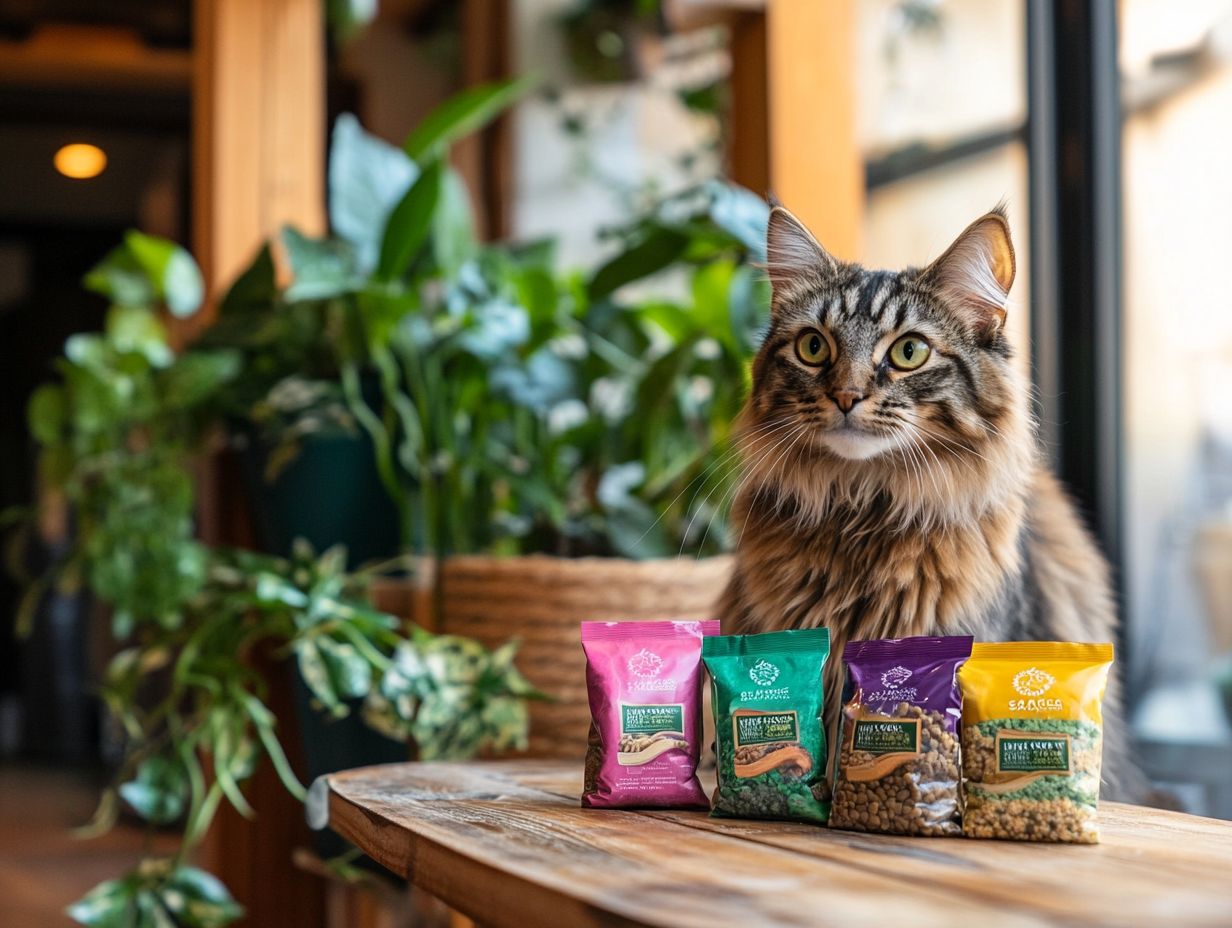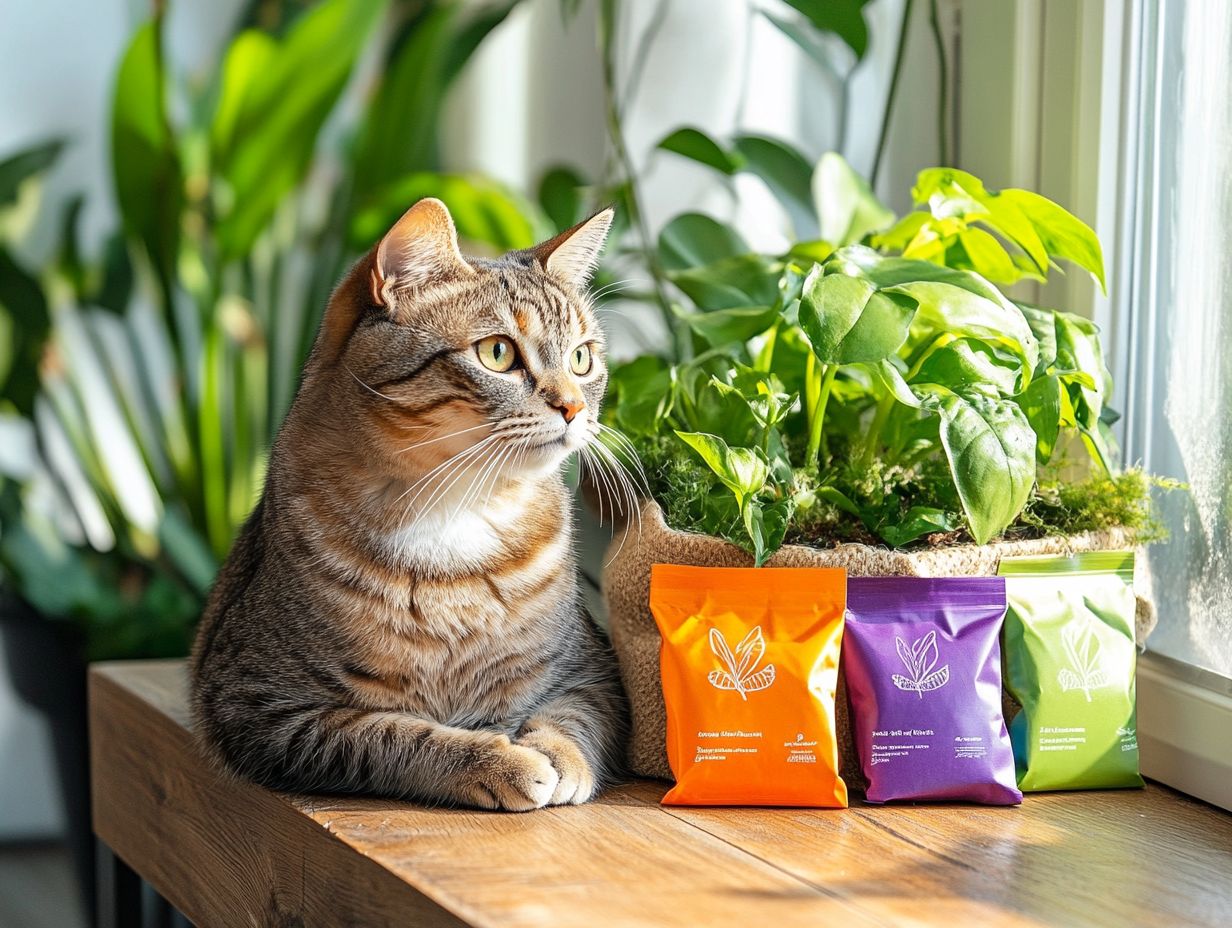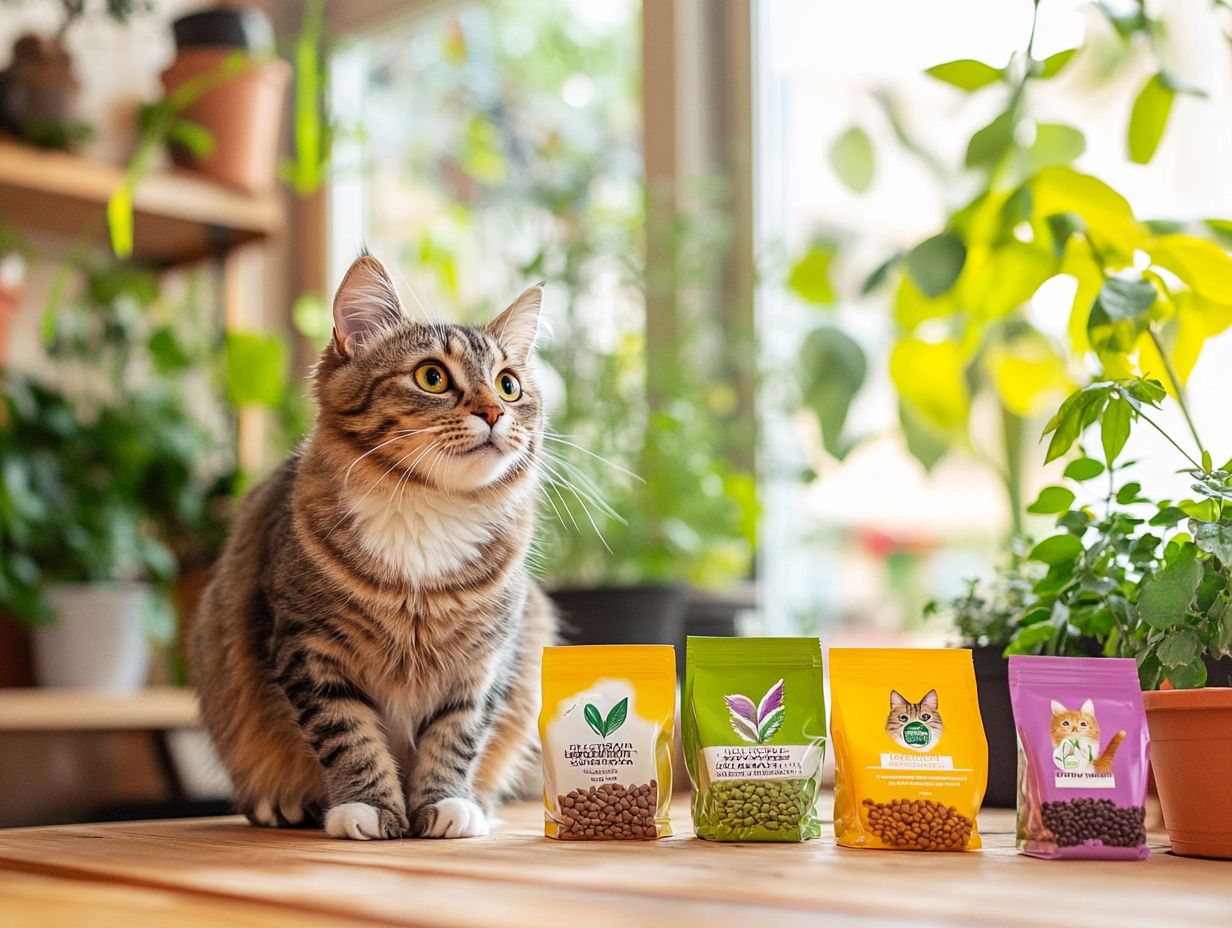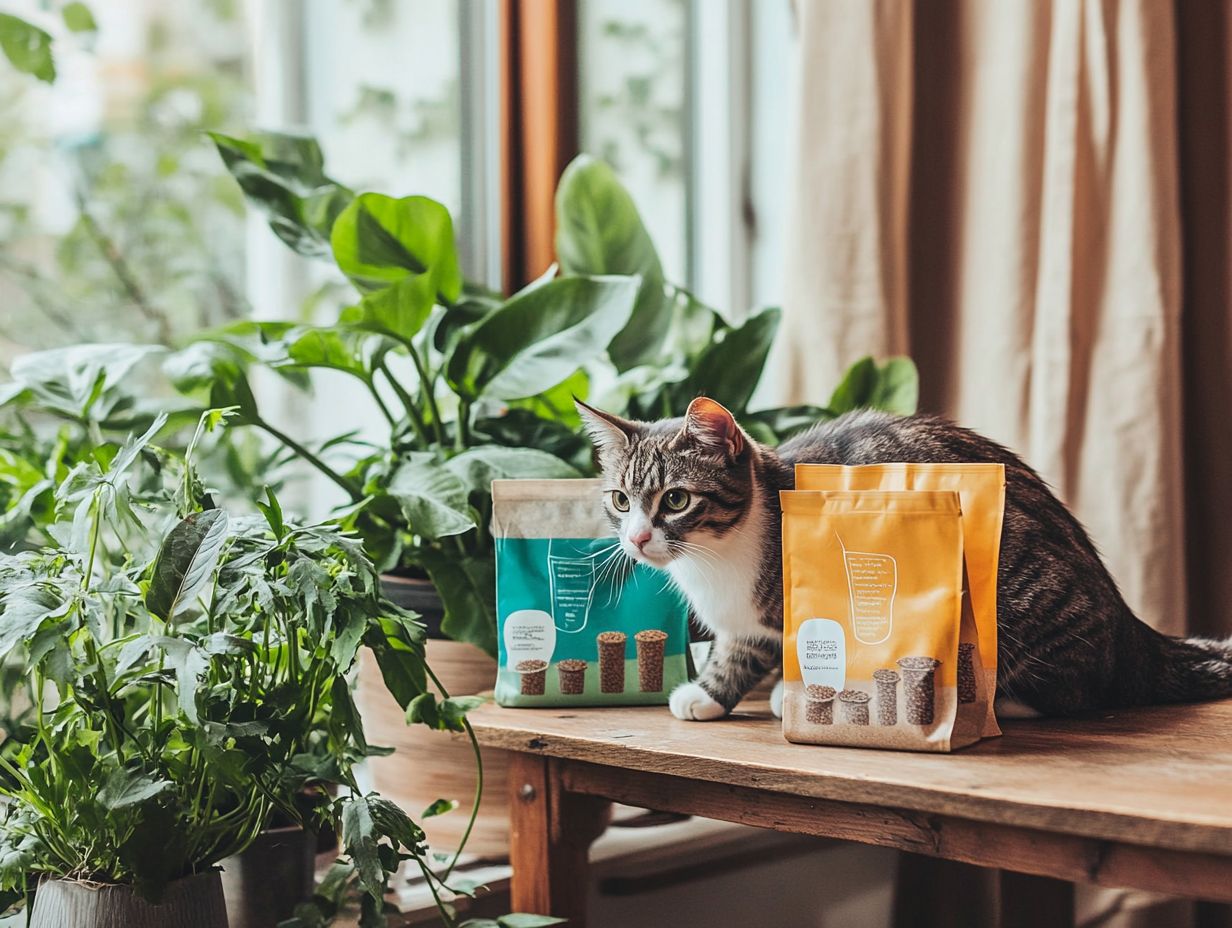As pet owners become increasingly aware of their environmental impact, choosing sustainable cat food brands has emerged as a top priority, driven by consumer awareness and ethical issues. While sustainability is important, it’s crucial to remember that cats are obligate carnivores, and animal-source proteins are essential for their health.
This decision benefits our planet and ensures that our feline friends receive high-quality nutrition, meeting their nutritional needs.
We will explore what makes a cat food brand sustainable, how to identify these eco-friendly options, and highlight some top brands you can feel good about feeding your cat, such as The Honest Kitchen and Open Farm.
Additionally, we will share tips for a smooth transition to sustainable food, emphasizing the necessity of consulting a veterinarian for special dietary needs, especially for cats with health conditions like kidney disease or diabetes. Join us in making a positive change for your pet and the planet!
Key Takeaways:

- Choosing sustainable cat food brands benefits the environment, your pet’s health, and reduces your high carbon pawprint.
- Sustainable cat food brands prioritize ethical ingredient sourcing, eco-friendly packaging, and sustainable manufacturing processes, including recycling initiatives and packaging recyclability.
- Look for certifications, read ingredient lists, and research the company’s practices, including transparency in sourcing and ethical accreditation, to identify truly sustainable cat food brands.
- Ensure any sustainable cat food is nutritionally complete and suitable for your cat’s specific life stage, such as for kittens or senior cats.
Why Choose Sustainable Cat Food Brands?
The selection of sustainable cat food brands reflects a growing awareness of both the nutritional needs of our pets and the environmental impact of our choices. The pet food industry significantly contributes to environmental issues, including plastic waste and concerns about animal welfare.
As a result, many consumers are becoming increasingly aware of ethical issues such as animal testing, factory farming, and slaughterhouse practices. They are actively seeking eco-friendly alternatives that align with their values.
What Makes a Cat Food Brand Sustainable?
Sustainable cat food brands can be identified by several factors that reflect environmental responsibility and ethical business practices.
- First, sourcing ingredients from local farms helps reduce carbon emissions associated with long-distance transportation, supporting local sourcing and community farming practices.
- Additionally, sustainable brands use recyclable packaging materials, such as glass or metal, to minimize waste and environmental pollution, often opting for biodegradable options.
- A commitment to renewable energy in manufacturing processes is another hallmark of a sustainable cat food brand.
These brands not only focus on the nutritional quality of their products but also consider their overall environmental impact, which is an increasingly important factor in today’s marketplace.
1. Ingredients Sourcing
Sourcing ingredients is crucial for evaluating the sustainability of cat food brands, as it affects both the nutritional needs of pets and the environment. Sustainable brands typically utilize organic and human-grade ingredients sourced from local suppliers to minimize transportation emissions, support community farming practices, and reduce their overall carbon footprint.
By using high-quality, ethically sourced ingredients, these brands contribute to a more humane and efficient food system. Brands like Wellness and Fromm aim to uphold ethical values by using responsibly sourced proteins and organic vegetables, ensuring that pets receive meals rich in essential nutrients.
This approach not only enhances the health of our cats but also builds trust with consumers who are increasingly mindful of the environmental and ethical implications of their purchasing decisions.
2. Packaging Materials
The choice of packaging materials is crucial for the sustainability of cat food brands, as the overuse of single-use plastics significantly contributes to global plastic waste. Sustainable cat food brands often opt for environmentally friendly packaging that is either recyclable or biodegradable, which helps reduce their carbon footprint and appeals to eco-conscious consumers.
When transitioning to sustainable food, it’s important to do so gradually to prevent digestive upset in cats. Proper food storage practices can enhance safety and nutrient preservation, ensuring that your cat’s food remains fresh. Always consult your veterinarian for guidance on appropriate diets and any special dietary needs.
Raw Diets: A Balanced View
While raw diets can offer high protein, they also pose risks, such as bacterial contamination. It is essential to consult your veterinarian to ensure that any diet you choose adheres to AAFCO and WSAVA guidelines for feline nutrition.
For instance, companies like Purina and Whiskas are systematically eliminating unnecessary plastic from their packaging in favor of plant-based materials. Recent reports indicate that nearly 40% of pet food brands are adopting sustainable packaging solutions, reflecting a positive trend, according to studies by [Insert Credible Source].
Case studies of pet food brands have demonstrated reductions of up to 60% in plastic usage by transitioning to alternative materials. Making these choices is essential for environmental protection and will become increasingly important as consumers become more aware of waste reduction and demand such changes.
This heightened awareness is likely to accelerate the pace of innovation among these brands, encouraging even more sustainable practices.
3. Manufacturing Processes
Manufacturing processes are crucial to the sustainability of cat food brands, as they significantly impact both environmental sustainability and animal welfare. Many brands are adopting renewable energy sources and ethical manufacturing practices, aligning their operations with corporate responsibility goals to reduce their overall carbon footprint.
For instance, companies like PetSmart incorporate solar energy in their production facilities to lessen the environmental impact of their operations. Additionally, some brands engage in sustainable sourcing practices, ensuring that their ingredients come from responsible fisheries and farms.
Corporate responsibility encompasses not only ecological stewardship but also fair labor practices, which an increasing number of brands are beginning to embrace. As consumers become more interested in the origins of their pet food, these practices not only help build brand loyalty but also foster a culture of sustainability that can permeate the entire industry.
How to Identify Sustainable Cat Food Brands?

Identifying sustainable cat food brands is straightforward if you know what to look for, enabling you to ensure proper nutrition for your pets while being mindful of the environment. Seek out certifications, such as ethical ratings or organic certifications, from reputable sources that indicate the company follows sustainable practices.
Additionally, examining ingredient lists and researching company practices will offer more insights into each brand’s commitment to sustainability and animal welfare, including the use of human-grade ingredients.
1. Look for Certifications
Certifications play a crucial role in assessing the sustainability of cat food brands, enabling consumers to make informed choices. Reputable organizations, such as the Global Animal Partnership and the Marine Stewardship Council, provide ethical accreditation that demonstrates a brand’s commitment to sustainable and humane practices.
Additionally, Humane Society International offers certifications that ensure animal welfare standards are met, allowing consumers to confidently know that their pet’s food is sourced responsibly. Organic certification signifies that the ingredients are produced without synthetic fertilizers or pesticides, promoting a healthier ecosystem.
Brands that obtain these certifications demonstrate their commitment to quality ingredients, environmental sustainability, and animal welfare. Consequently, certified products enable consumers to make educated decisions that reflect their values while caring for their cats.
2. Read Ingredient Lists
The best way to identify sustainable cat food brands is by examining their ingredient lists, as the quality of these ingredients significantly impacts pets’ nutritional profiles and overall health. Cats are obligate carnivores, so brands that prioritize animal-source proteins, like chicken or fish, are essential for meeting their dietary needs.
It is crucial not to underestimate the importance of each ingredient; the primary protein source should always be listed first. Avoid products that contain high levels of fillers like corn and soy, as these can undermine a cat’s dietary needs and lead to potential nutritional deficiencies, particularly in essential amino acids like taurine.
Instead, opt for foods that are rich in essential fatty acids and vitamins, which enhance the immune system and contribute to shinier coats. High-quality ingredients not only ensure proper nutrition for pets but also promote long-term health while being environmentally friendly. Always consult with a veterinarian before changing your cat’s diet, especially if considering raw or homemade options.
3. Research the Company’s Practices
When researching brands, look into their food storage and handling practices to prevent spoilage and ensure food safety. While ethical practices are important, the primary focus should always remain on the health and nutritional needs of your cat.
Researching a company’s practices can help consumers assess the extent to which brands are committed to sustainability and corporate responsibility. Consumers should seek out brands that are transparent about their ingredient sourcing and have clearly defined sustainable practices, as this information is often readily available on the brand’s website or through customer service.
By doing so, consumers can better understand how their purchasing decisions align with their ethical values and how those choices impact environmental sustainability.
Sustainable brands typically provide information about their supply chains, including where their materials are sourced and how they are harvested, reflecting the brand’s overall ethical framework. Awareness of such information informs purchasing decisions and is essential for responsible consumption, ensuring that purchases are made from companies with a genuine commitment to ecological sustainability.
This informed and value-driven approach to purchasing ultimately contributes to a healthier planet and a more sustainable future for everyone, including cat owners who prioritize their pets’ health and well-being.
Top Sustainable Cat Food Brands
Among the top sustainable cat food brands are Wild Earth, Tender & True, and James Wellbeloved, known for their ethical practices and commitment to sustainability.
The market for sustainable cat food brands is experiencing rapid growth, with numerous options now available for cat owners who prioritize their pets’ health and well-being who are concerned about environmental claims and ethical issues in the pet food industry.
Notable brands in this space include Wild Earth and Open Farm, alongside others like Tender & True, Pooch & Mutt, and Purina, all of which are contributing to the overall sustainability of the pet food sector.
1. Wild Earth
Wild Earth focuses on providing high-quality ingredients and eco-friendly products to deliver essential nutrients for cats. It is important to note that cat owners should consult with a veterinarian before considering any diet that implies non-meat-based options, as cats are obligate carnivores and require animal-source proteins for balanced nutrition.
The brand is committed to animal welfare and sustainability, offering ethical and eco-friendly solutions within the pet food industry.
2. Open Farm

Open Farm is recognized for its dedication to ethical sourcing and transparency in sourcing, obtaining ingredients from local farms to produce high-quality cat food that addresses environmental impact. Their emphasis on sustainability and community engagement has made them a favored choice among cat owners who prioritize these values in the pet food industry. However, it’s crucial to ensure that the sourcing practices do not compromise the nutritional quality needed for cats.
3. Tiki Cat
Tiki Cat is a high-protein cat food brand that focuses on sustainable seafood to meet the growing demand for environmentally conscious and ethically sourced pet foods, emphasizing environmental sustainability and sustainable practices. The brand has built a strong reputation among cat owners who prioritize high-quality nutrition for their pets.
Tiki Cat aims not only to improve pet health but also to support the marine ecosystem through responsible sourcing practices. Their recipes are crafted with real fish and meat, designed to mimic a cat’s natural diet. By using only sustainably caught fish, Tiki Cat addresses the critical issue of overfishing. Through this commitment, they actively contribute to the availability of eco-friendly pet food options for cat owners but must ensure a balanced diet to prevent deficiencies.
4. Ollie
Ollie is a new pet food brand that prioritizes human-grade food quality, ingredient sustainability, and sustainable practices. Their health-focused recipes are crafted to meet the nutritional needs of pets, while their commitment to environmentally sustainable sourcing reflects their dedication to the planet. It is also essential for cat owners to ensure that all diets meet AAFCO and WSAVA guidelines for nutritional adequacy.
5. NomNomNow
NomNomNow is regarded as one of the best sustainable cat food brands due to its commitment to producing fresh meals from organic ingredients while maintaining high-quality control and minimizing its carbon footprint. This approach ensures that cats receive nutritionally dense meals while minimizing environmental impact. The company sources its ingredients from trusted organic farms, promoting the health of both pets and the planet. As a result, every bite is packed with essential nutrients and produced in an environmentally friendly manner.
To maintain the nutrient quality of sustainable cat food, it is crucial to store it properly in a cool, dry place, and avoid exposure to moisture and heat to prevent spoilage.
By using seasonal and local ingredients, NomNomNow also reduces the carbon footprint associated with long-distance shipping. As the company continues to innovate in the pet food market, it embodies the forward-thinking philosophy that many pet owners seek in a brand dedicated to providing nutrition that meets feline dietary needs and the environment.
Tips for Transitioning Your Cat to Sustainable Food
Transitioning your cat to sustainable food requires careful consideration to ensure that your pet adapts smoothly to their new diet. It’s important to remember that cats are obligate carnivores, meaning they require animal-source proteins to thrive. Begin by gradually mixing the new food with the old, allowing their digestive system to acclimate to the change.
It is also important to closely monitor your cat’s health and note their dietary preferences during this transition to ensure they remain both happy and healthy. Consider consulting a veterinarian, especially if you are considering a raw or vegan diet, to address any potential nutritional deficiencies.
1. Introduce New Food Gradually
Gradually introducing new food is essential for ensuring that a sustainable cat food transition is effective. This approach allows the cat’s digestive system to adjust to the change without causing distress. Some cats may require longer adjustment periods based on their specific health and behavioral needs.
By mixing a small amount of the new food with the current diet and gradually increasing the proportion over several days, you can facilitate a slower adaptation process while carefully monitoring for any adverse reactions. Ideally, over the course of a week or more, you should adjust the mixture until the old food is completely phased out. This method not only aids in gut acclimatization but also reduces the risk of gastrointestinal upset. Abrupt dietary changes can lead to health risks, including gastrointestinal upset, so monitoring is crucial.
If there are frequent changes in the cat’s appetite or bowel movements, it may indicate the need for further adjustments in the introduction process or suggest other underlying issues.
2. Mix in Some of Their Old Food

For picky eaters or cats with specific health issues, gradually mixing some of their old food with the new sustainable food can make the transition easier. This approach provides a familiar taste and texture, helping to prevent rejection, especially when the nutritional profile of the new product significantly differs from previous options.
By slowly introducing the new food, cat owners not only cater to their pets’ established preferences but also promote better digestion and acceptance of healthier ingredients. This method allows cats to experience the nutritional benefits of sustainable products while easing any anxiety that may arise from a sudden dietary change.
It also aims to address common health concerns, ensuring that picky eaters receive a balanced diet and, in turn, promoting their overall health and activity levels.
3. Monitor Your Cat’s Health and Behavior
Monitoring the health and behavior of cats during the transition to sustainable food is essential for identifying any necessary dietary adjustments that may enhance their well-being and meet their nutritional needs. Pay special attention to specific health conditions, such as kidney disease or diabetes, and consider how tailored nutrition can play a role.
Observing changes in energy levels, coat condition, and overall happiness can help determine how well cats are adapting to their new diet. This observation phase can yield valuable insights into how effectively a feline’s body is adjusting to the new food, providing clues about any potential discomfort or distress the pet may be experiencing. Even subtle changes in a cat’s behavior, such as increased lethargy or alterations in grooming habits, can signal the need for further dietary adjustments.
Changes in behavior may also correlate with health indicators like weight and digestive health, highlighting the critical role nutrition plays in the overall health of cats.
Frequently Asked Questions
What makes a cat food brand sustainable?
A sustainable cat food brand is one that considers the environmental impact of its ingredients, packaging, and production processes. This includes using ethically sourced ingredients, biodegradable packaging, and implementing eco-friendly practices in their operations.
Why should I choose a sustainable cat food brand?
Choosing a sustainable cat food brand not only benefits the environment, but it also benefits your cat’s health. These brands often use high-quality, natural ingredients that are better for your cat’s digestive system and overall well-being.
Are there any affordable sustainable cat food brands?
When selecting sustainable options, always check for potential allergens and toxic ingredients that could be present in some sustainable food options. Proper food storage and handling practices, including temperature control and expiration dates, are essential to maintain food safety and quality.
Yes, there are several affordable sustainable cat food brands available. However, while affordability and sustainability are important, it’s crucial to prioritize your cat’s dietary needs as obligate carnivores, which require animal-source proteins. Look for brands that use minimal packaging and source their ingredients locally, as these factors can help lower the cost of production and make the brand more affordable.
Can I find sustainable cat food brands at my local pet store?
Yes, many pet stores now carry a variety of sustainable cat food brands. It’s always a good idea to check the label and do some research on the brand before making a purchase. Additionally, cat owners should consult with their veterinarians regarding the nutritional adequacy of any sustainable brand, as not all brands may meet AAFCO or WSAVA standards.
Are there any vegan or vegetarian options for sustainable cat food?
Yes, there are several vegan and vegetarian options for sustainable cat food. These brands use plant-based proteins and other natural ingredients to provide a well-balanced diet for your cat without relying on animal products. However, it’s important to note that such diets can lead to potential nutritional deficiencies for cats. Consulting with a veterinarian before choosing these options is highly recommended.
Do sustainable cat food brands offer a complete and balanced diet for cats?
Yes, most sustainable cat food brands claim to offer a complete and balanced diet for cats. However, it’s essential to verify that they meet AAFCO’s nutritional profiles specifically for cats, rather than just making general claims. Furthermore, some sustainable brands may not cater to the unique dietary needs of cats with health conditions like kidney disease or diabetes.
Pet owners should also be cautious about allergens and toxic ingredients in all food types. Be aware of your individual cat’s sensitivities and seek veterinary advice if unsure.
When managing cat food, it’s important to store and handle it properly to prevent spoilage. Look for signs of spoilage, such as an off smell or change in texture, and discard any food that seems compromised. Additionally, transitioning diets gradually is crucial—particularly when switching to new brands—to avoid gastrointestinal upset.
Lastly, balance practical feeding advice with current research and guidelines, especially regarding weight management in cats, to ensure your pet’s health and well-being.